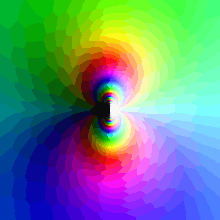Essential singularity

_-Schilling_XIV%2C_6_-_312-_(2).jpg)
In complex analysis, an essential singularity of a function is a "severe" singularity near which the function exhibits odd behavior.
The category essential singularity is a "left-over" or default group of singularities that are especially unmanageable: by definition they fit into neither of the other two categories of singularity that may be dealt with in some manner – removable singularities and poles.
Formal description
Consider an open subset U of the complex plane C. Let a be an element of U, and f : U \ {a} → C a meromorphic function. The point a is called an essential singularity of the function f if the singularity is neither a pole nor a removable singularity.
For example, the function f(z) = e1/z has an essential singularity at z = 0.
Alternate descriptions
Let a be a complex number, assume that f(z) is not defined at a but is analytic in some region U of the complex plane, and that every open neighbourhood of a has non-empty intersection with U.
If both
 and
and  exist, then a is a removable singularity of both f and 1/f.
exist, then a is a removable singularity of both f and 1/f.
If
Similarly, if
 does not exist but
does not exist but  exists, then a is a pole of f and a zero of 1/f.
exists, then a is a pole of f and a zero of 1/f.
If neither
 nor
nor  exists, then a is an essential singularity of both f and 1/f.
exists, then a is an essential singularity of both f and 1/f.
Another way to characterize an essential singularity is that the Laurent series of f at the point a has infinitely many negative degree terms (i.e., the principal part of the Laurent series is an infinite sum). A related definition is that if there is a point  for which
for which  is not differentiable for any integer
is not differentiable for any integer  , then
, then  is an essential singularity of
is an essential singularity of  .[1]
.[1]
The behavior of holomorphic functions near their essential singularities is described by the Casorati–Weierstrass theorem and by the considerably stronger Picard's great theorem. The latter says that in every neighborhood of an essential singularity a, the function f takes on every complex value, except possibly one, infinitely many times.
References
- ↑ Weisstein, Eric W. "Essential Singularity". MathWorld, Wolfram. Retrieved 11 February 2014.
- Lars V. Ahlfors; Complex Analysis, McGraw-Hill, 1979
- Rajendra Kumar Jain, S. R. K. Iyengar; Advanced Engineering Mathematics. Page 920. Alpha Science International, Limited, 2004. ISBN 1-84265-185-4